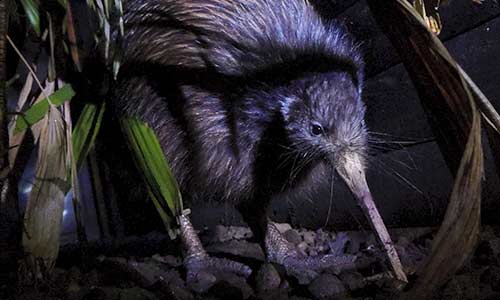Brown Kiwi
Apteryx mantelli

About the Brown Kiwi

Geographic Range:

Class: Aves
Order: Struthioniformes
Family: Apterygidae
Genus: Apteryx
Species: mantelli
Kiwis are small, flightless and nearly wingless birds. They're the smallest of the ratites, a distinct group of large, flightless birds. Kiwis vocalize by hissing, growling and grunting. To find one another in the dark as well as to defend their territories, kiwis can shriek loudly. This cry sounds like “kee-wee, kee-wee,” earning the bird its name.
Brown Kiwi Facts
Appearance:
Kiwis are small, flightless and nearly wingless birds. They are the smallest of the ratites, a group of flightless birds that include the ostrich, rhea, emu and cassowary. Most birds have a ridge on their sternum (a keel) where flight muscles attach, but ratites don't need keels because they don't fly. Although flightless, kiwis have small vestigial wings that are hidden by their feathers, so they appear to have no wings at all.
Kiwis have four toes, whereas other ratites have only two or three. They have a unique beak with nostrils and specialized vibration/pressure-sensing nerve endings located at its tip to allow them to both smell and detect movement of prey in the soil. Kiwis also have modified feathers on their face that act as whiskers.
Size:
Weights vary greatly among individuals and populations, and females tend to be larger than males.
- Adult males range from 3.8 to 6.7 pounds
- Females range from 4.6 to 8.8 pounds
- Male bill length ranges from 3.2 to 4.7 inches
- Female bill length ranges from 4.4 to 6.2 inches. Females have a longer bill length than males.
Diet:
The majority of a kiwi's diet consists of small invertebrates including earthworms, beetle larvae, caterpillars, crickets, snails and crayfish. They also eat seeds and native fruits.
Reproduction:
Peak breeding season is between June and December. Captive brown kiwis tend to lay their eggs between November and March, although eggs have been produced year round. Kiwis typically pair for life, but a female may choose a new mate if a more desirable male catches her eye. Kiwis reach sexual maturity at 2 to 4 years of age, although some males have been known to breed after one year.
Females lay one or two eggs per clutch, with one to three clutches in a season. It takes about a month for eggs to form internally before laying. The eggs are white, very large, and approximately 15% of the female’s body weight. Incubation is performed solely by the male. Chicks are precocious and fully developed when hatched. Chicks leave the nest burrow after a week, following the male to food sources. They are not fed by their parents and disperse from the natal territory at 1 to 6 months of age.
Behavior:
Brown kiwis are flightless and mostly nocturnal. During the day, they rest in burrows, hollow trees or under thick vegetation and emerge shortly after dark. They feed by tapping their bill to the ground, using their well-developed senses of smell and hearing to detect invertebrates in the ground. Kiwis are socially monogamous and strongly territorial, especially during the breeding season. They will call occasionally each night to advertise territories and maintain contact with mates.
These birds use a range of grunts, growls, hisses and shrieks to mark territories and remain in contact with their partners. The name “kiwi” is derived from the male’s ringing call, “kee wee!"
Habitat/Range:
The five species of kiwi (little spotted kiwi, great spotted kiwi, rowi, tokoeka, and brown kiwi) are all endemic to New Zealand. The brown kiwi has four distinct populations located in Northland, Coromandel, eastern and western North Island. The preferred habitats are lowland and coastland forests. However, due to fragmentation and loss of these habitats, kiwis have become common in exotic pine forests, swamps, scrublands and reclaimed farmlands.
Median Life Expectancy:
20 years in the wild
Threats in the wild:
Habitat loss and predation by mammalian predators, including dogs, ferrets and stoats.
Fun Facts:
- Kiwis have many traits that are uncommon for a bird, but common for a mammal. These include whiskers, straight and fur-like feathers, nostrils on the end of their beak, and an acute sense of smell.
- Despite its small size, a kiwi can outrun a human.
- The kiwi is New Zealand’s national bird.
- The kiwi's closest genetic relative is the extinct elephant bird from Madagascar.
You Can Find This Animal in the Outback Trail
Kiwi Feather Collection
Zoo New England works with other Zoos across the country in a kiwi feather collection project. Brown kiwi feathers are collected and later shipped to New Zealand to be used in traditional Maori weaving. Kiwis, the country’s national bird, are an endangered species due to habitat loss and predation. The feather collection project helps strengthen Zoos’ roles in New Zealand’s conservation and cultural recovery efforts.
You might also like
At Franklin Park Zoo:
At Stone Zoo:

